Design and development
Browning hired two Lockheed engineers, Pete Law and Bruce Boland, and a team of other specialists to make major modifications to the plane, including installation of a Rolls-Royce Griffon 57 engine and contra-rotating propellers from an Avro Shackleton. [2] [3] The larger engine required significant changes to the airframe, particularly the engine compartment. The contra-rotating propellers also created instability that required an increase in fin area, all of which cost Browning more than $300,000. [4]
With these changes, the aircraft became the dominant racer on the Unlimited circuit. [5] It was initially flown by Mac McClain and Daryl Greenamyer; in 1976, Greenamyer recommended Steve Hinton pilot the plane. Hinton won four consecutive Unlimited races in one year, and remains the only pilot ever to do so. [6]
History
On August 14, 1979, Hinton set the piston-driven aircraft 3-kilometer world speed record at 499.018 mph [7] [8] at Tonopah, Nevada, making Hinton, age 27, the youngest person ever to capture the speed record. The team was hoping for 100+ degree temperatures in the Nevada desert, conditions under which they believed they could achieve 530 mph. [9] The weather did not cooperate, however, and the cool 68-degree air held their speed just under 500 mph. Even so, the record held for a decade.
On September 16, 1979, Hinton was racing the RB-51 in the Reno Air Races when a capacitor in the magneto failed, causing the engine to run on half its spark plugs. Not knowing what was wrong, Hinton pushed the plane to full throttle. This resulted in the supercharger carrying the extra pressure. Eventually, a bearing in the supercharger failed. Hinton finished the race in second place and moved to make an emergency landing. The supercharger failure resulted in a shaft failure, however; that shaft drove the oil pump, which in turn controlled the propeller pitch. The propellers went flat, acting as a huge air brake. The RB-51 crashed short of the runway. The wings were sheared off as the plane came down between two piles of rock and the fuel erupted in a fireball. The cockpit was thrown end-over-end away from the fire, yet Hinton survived with a broken back, leg, and ankle. [10] [11] His survival is attributed by one of the lead engineers, Pete Law, to additional braces and a roll bar installed on the cockpit. [12]
The Red Baron was destroyed in the crash. Steve Hinton's company, Fighter Rebuilders, moved the dataplate, tailnumber 413334, and registration number NX7715C to P-51D serial number 44-73053, Wee Willy II. [13]
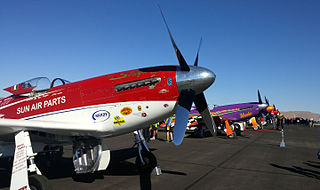
The Reno Air Races, officially known as the National Championship Air Races, are a multi-day event tailored to the aviation community that took place each September at the Reno Stead Airport a few miles north of Reno, Nevada, with the last races held in 2024. The Reno Air Racing Association plans to resume racing at a new venue in 2025. Air racing is billed as "the world's fastest motor sport" and Reno was one of the few remaining venues. The event includes races in six classes and demonstrations by airshow pilots.
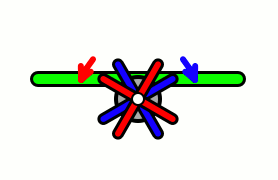
Aircraft equipped with contra-rotating propellers (CRP) coaxial contra-rotating propellers, or high-speed propellers, apply the maximum power of usually a single piston engine or turboprop engine to drive a pair of coaxial propellers in contra-rotation. Two propellers are arranged one behind the other, and power is transferred from the engine via a planetary gear or spur gear transmission. Although contra-rotating propellers are also known as counter-rotating propellers, the term is much more widely used when referring to airscrews on separate non-coaxial shafts turning in opposite directions.
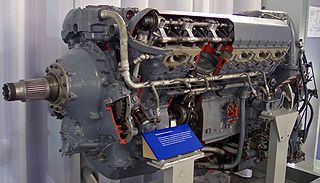
The Rolls-Royce Griffon is a British 37-litre capacity, 60-degree V-12, liquid-cooled aero engine designed and built by Rolls-Royce Limited. In keeping with company convention, the Griffon was named after a bird of prey, in this case the griffon vulture.

The Curtiss XP-62 was a prototype single-engine interceptor aircraft, that was built for the United States Army Air Forces, by the Curtiss-Wright Corporation. It first flew in 1943.
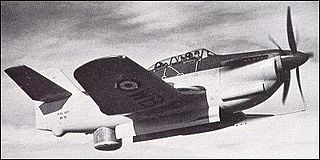
The Blackburn B-54 and B-88 were prototype carrier-borne anti-submarine warfare aircraft of the immediate post-Second World War era developed for the Royal Navy's Fleet Air Arm (FAA). They shared a conventional monoplane design with a mid-mounted inverted-gull wing and tricycle undercarriage. The pilot and observer sat in tandem under a long canopy atop the fuselage. The B-54 had a piston engine while the B-88 had a gas turbine driving large contra-rotating propellers. The radar scanner was mounted in a retractable radome in the rear fuselage, behind a long internal weapons bay. The program was cancelled in favour of the Fairey Gannet aircraft.
Darryl George Greenamyer was an American aviator. He started his flying career in the US Air Force Reserve. After leaving the Air Force, he then began to work at Lockheed where he eventually became an SR-71 test pilot at Skunk works. While working at Lockheed he met many of the engineers who would later help him make modifications to future race planes. He won his first victory in the Unlimited Class at the Reno Air Races in 1965. He is the third most successful competitor in Reno Air Race history.
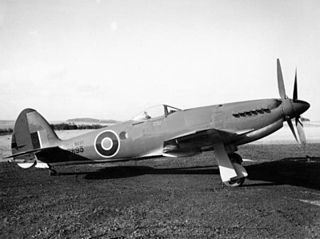
The Supermarine Seafang was a British Rolls-Royce Griffon–engined fighter aircraft designed by Supermarine to Air Ministry specification N.5/45 for naval use. It was based on the Spiteful, which was a development of Supermarine's Griffon-engined Spitfire aircraft. By that time the Spitfire was a 10-year-old design in a period of rapid technical development in aviation. The Seafang was outmoded by jet aircraft, and only 18 were built.

Rare Bear is a highly modified Grumman F8F Bearcat that saw major success at the Reno Air Races over multiple decades.

The Supermarine Seagull was a British amphibious, military flying boat and the last to be built by the Supermarine company. Design started during the Second World War but it did not fly until three years after the war had ended and the project was cancelled without it being adopted for service.

Dago Red is a North American P-51 Mustang (44-74996), restored as a competitive air racer by Frank Taylor in 1981. Dago Red holds several world records, including the 15 km (517.323 mph) set in 1983. Frank Taylor piloted the plane to most of its world records in the 1980s.
A number of aircraft have been claimed to be the fastest propeller-driven aircraft. This article presents the current record holders for several sub-classes of propeller-driven aircraft that hold recognized, documented speed records in level flight. Fédération Aéronautique Internationale (FAI) records are the basis for this article. Other contenders and their claims are discussed, but only those made under controlled conditions and measured by outside observers.

Over twenty variants of the North American P-51 Mustang fighter were produced from 1940, when it first flew, to after World War II, some of which were employed also in the Korean War and in several other conflicts.
The Wright R-4090 Cyclone 22 was an American experimental radial piston engine designed and built in prototype form by Wright Aeronautical during the 1940s.

Steve Hinton is an American aviator who held a world speed record from 1979 to 1989 and won six Unlimited-class air races, including two national championships. He won four consecutive Unlimited races in one year.
The Red Baron was a highly modified Lockheed F-104 Starfighter which set a FAI Class C-1 Group III 3 km speed record of 1,590.45 kilometres per hour (988.26 mph), in 1977 which still stands. It was assembled by Darryl Greenamyer and sponsored by Ed Browning and the Red Baron Flying Service of Idaho Falls, Idaho. The aircraft was destroyed in an accident in 1978.
Lyle Thomas Shelton (1934–2010) was an American aviator who set the world's absolute propeller-driven 3-kilometer speed record of 528.329 mph. He was born in Brownfield, Texas on June 15, 1933. A former US Naval Aviator, he was an airline pilot for his professional career, flying for Trans World Airlines (TWA). During his career at TWA, he flew Boeing 707s, 727s, Douglas DC-9s and the Lockheed L-1011. He retired from TWA in 1991.

The Galloping Ghost was a P-51D Mustang air racer that held various airspeed records and whose fatal crash in 2011 led to several NTSB recommendations to make air shows safer.

Voodoo is a highly modified North American P-51 Mustang that was the 2013, 2014 and 2016 Unlimited-class champion of the Reno Air Races. The pilot for these wins was Steven Hinton, Jr of Chino, California.

Precious Metal is a custom-built racing aircraft based on the North American P-51 Mustang.

Miss Ashley II was a custom-built racing aircraft based on the North American P-51 Mustang.















